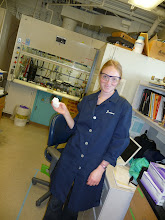
Depending on who you ask, Group 3 (the third vertical column from the left) of the periodic table includes:
- Scandium, Sc
- Yttrium, Y
- Lanthanum, La
- Actinium, Ac
OR
- Scandium, Sc
- Yttrium, Y
- Lanthanum-Lutetium (La-Lu) <--- "lanthanides"
- Actinium-Lawrencium (Ac-Lr)<--- "actinides," radioactive!
OR
- Scandium, Sc
- Yttrium, Y
- Lutetium, Lu
- Lawrencium, Lr
The different classifications arise from the different logical ways of potentially arranging the elements, e.g., the first arrangement includes La and Ac, both of which are the first elements in the two rows of "f-block" elements (but both behave more like d-block metals), etc. We won't go into it anymore than that here...
The Group 3 elements, as well as the vast majority of the lanthanides and actinides (f-block), can be found hanging out together within the Earth's crust. Of the four (or 32, depending on who you're asking) group 3 elements, Yttrium has perhaps the most real world applications. Due to its ability to form compounds thatphosphoresce, it is used in the manufacture of phosphors for electronic device displays.
The mnemonics for the transition elements are more conveniently formed for periods rather than groups, since four-word sentences are a little hard to come by... So... Once we get to group 12, we will have four new mnemonics to learn!




